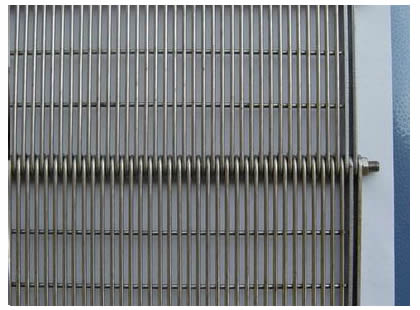Eye flex conveyor belt
Eye flex conveyor belts are specially designed for applications requiring an extremely rugged structure and long service life. With larger open areas, eye flex conveyor belts are generally used in chemical industry, steel industry and food industry such as drying, washing, baking, pasteurizing, frying, freezing and cooling, etc.
Features:
-
High strength and excellent carrying ability.
-
Open flat surface for superb air circulation and fluid drainage.
-
High reliability, durability with long service life even being used in 24/7 product line.
-
A wide range of materials and sophisticated designs for virtually every application.
-
Offer continuous product support minimizing product marking.
-
Smooth and single level surface without product entrapment.
-
Excellent resistance against shock and lateral forces.
Four styles of eye-links
Eye flex conveyor belts can be manufactured with various styles of eye-links: eye flex belt without spacer, eye flex belt with under welded spacing, eye flex belt with rings as spacers and eye flex belt with springs as spacers as shown in the following pictures:

Eye flex conveyor belt ECB Without spacers

Eye flex conveyor belt EBUW With under welded wire spacing

Eye flex conveyor belt EBRS With rings as spacers

Eye flex conveyor belt EBSS With springs as spacers
-
ECB belts are standard conveyor belts with the simplest structure based on a straight modular form without any spacers and springs. This design provides ECB belts flat conveying surface, open mesh configuration as well as excellent product conveying flow. Meanwhile, these belts are easy to clean and maintain just by means of replacing the broken part with minimal cost. ECB belts are ideal for food freezing, frying, cleaning, baking and other applications where no cross support is required.
-
EBUW belts features steel rods which are welded under the belt to avoid breeding ground for germs, such as areas under the spacers, springs, rings and sleeves. In this way, EBUW belts are the best choice for applications needing high hygiene and sanitation including row meat, poultry and fish processing, vegetable washing and drying, etc.
-
EBRS belts are characterized by rings as spacers to enlarge the gap of the conveyor belt for better air circulation and fluid drainage. So EBRS Belts will enhance the efficiency of your process and generally used in large product conveying, vegetable blanching, container pasteurization as well as food cooking, baking and cooling. As your request, plastic sleeves can be used to keep a distance between the wire links.
-
EBSS belts features the placement of spring between eye-link wires to create a more stable structure - that is because the springs make the eye-link wires able to move on the cross rods. Meanwhile, the springs also enlarge the open area and ease the cleaning and sanitizing of EBSS conveyor belts. Normally, they are applied in product conveying, vegetable blanching as well as jars, bottles, & cans pasteurization, etc.
Four styles of belt edges

Standard plate edge

Reinforcing plate edge

Chain link edge

Side guard edge
-
Standard plate edge - As the simplest belt edge, it is characterized by pieces of steel plates fastened to the cross rod by welding steel rings at the end for containing the integrity of the conveyor belt.
-
Reinforcing plate edge - This type of edge features added reinforcing plates mounted to the conveyor belts before the connecting rod is welded. This design increases the width of belt as well as enhances the strength of this belt.
-
Chain link edge - The chain link edges not only provide an alternative driving method but also make the belt much stronger than reinforcing plate edge.
-
Side guard edge - Side guard edges features erect side plates to protect conveying products from falling off from the belt. As your request, guard plates can also be mounted across the belt for food separation.
Details:
-
Materials: SS 304, SS 316.
-
Diameter of wire links: 1.2 mm, 1.5 mm, 1.6 mm, 1.8 mm, 2 mm, 2.5 mm, 3 mm.
-
Chain pitch: 25.4 mm, 31.75 mm, 38.1 mm, 50.8 mm, 63.5 mm, 76.2 mm.
-
Rod diameter: 5 mm, 6 mm, 7 mm, 8 mm, 10 mm, 12 mm.
-
Spiral pitch: 2.4 mm to 100 mm.
-
Rod pitch: 25.4 mm, 31.75 mm, 38.1 mm, 50.8 mm, 63.5 mm, 76.2 mm.
-
Belt width: 200 mm to 6,000 mm.
-
Belt length: any desired length.
-
Belt gap: 2 mm to 50 mm.
-
Open area: 20% to 90%.
-
Standards: complying with FDA, GMP, 1935/2004/EC or other standards as your request.







